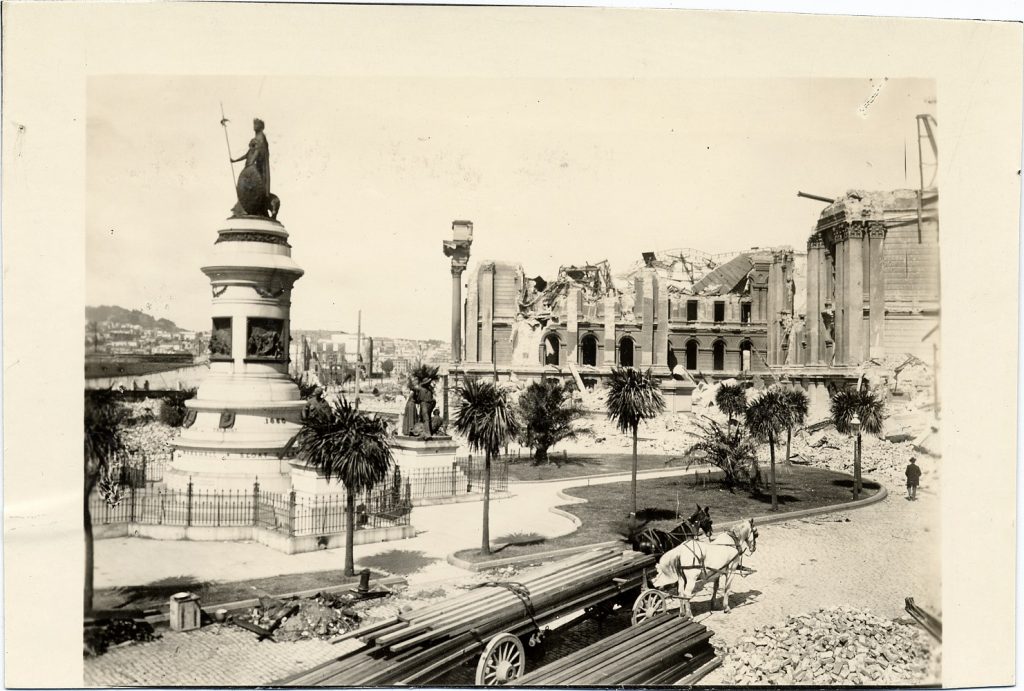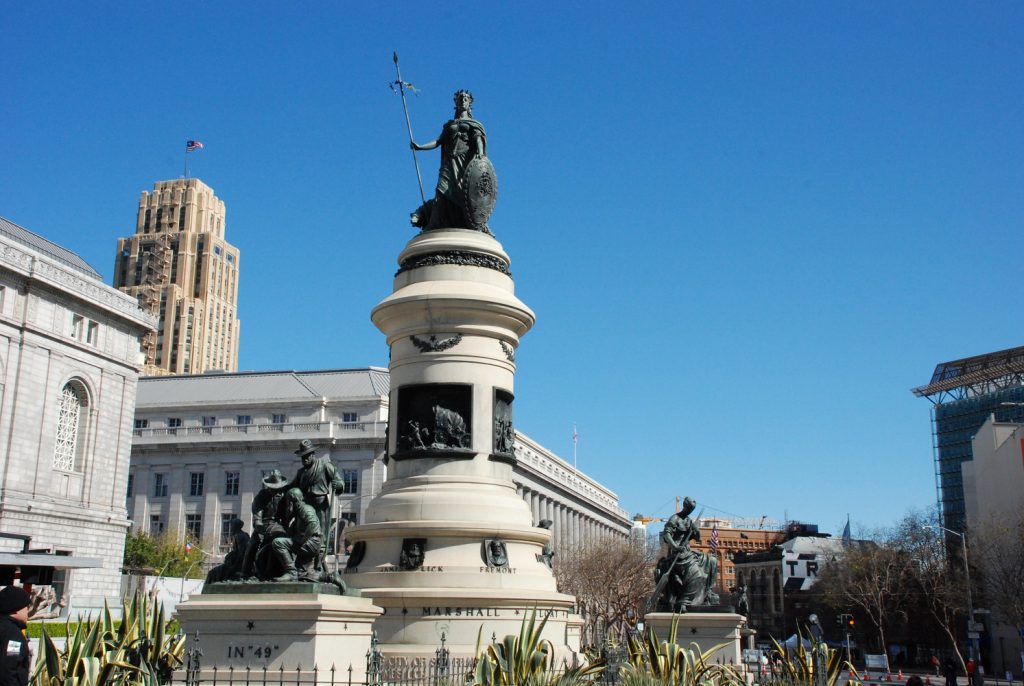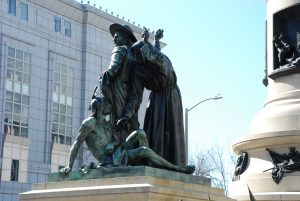San Francisco-based artist Frank Happersberger (1859-1932) sculpted that city’s James Lick Pioneer Monument to write a history of white American dominance on the California landscape. Yankee-born James Lick (1796-1894) earned a small fortune as a carpenter and piano builder in South America. He then multiplied that fortune by investing in San Francisco real estate during the California gold rush. This eccentric millionaire refused to leave his fortune to his illegitimate son. Instead, he chose to support his philanthropic interests and to place physical tributes to his own success on the San Francisco landscape.[1] Lick left a stunning $100,000 ($2.8 million in 2015 dollars) to the City of San Francisco to fund bronze “statuary emblematic of the significant epochs in California history” since the Spanish mission era.[2] The resulting monument was erected in front of San Francisco’s City Hall. Although that 1897 City Hall was soon destroyed the city’s enormous 1906 earthquake and fire, Lick’s forty-seven-feet-tall, 800-ton monument stubbornly survived. It soon became a symbol of the city’s determination to rebuild.


The granite pillar is encircled by portrait medallions of white men that Happersberger credited with collectively founding California. The artist began his narrative with Sir Francis Drake claiming the region for England in 1579 and Father Junipero Serra establishing the Spanish missionary system that brought Christianity and white settlement to California in 1769. Rather than celebrate the wealthy Latino landowners who dominated Mexican California’s cattle ranching economy after 1821, Happersberger chose to honor Swiss immigrant John (Johann) Sutter, who relied on Native labor to run his colony until gold was discovered in his mill race. Americans explorer and leader of the Bear Flag Revolt John C. Frémont and monument donor James Lick round out Happersberger’s honor roll.
Beneath these labeled portraits appear more names associated with California history. Four were Spanish or Mexican leaders: Spanish soldier and explorer Juan Rodriguez Cabrillo, Spanish military leader Gaspar de Portolá, Mexican governor and military commander José Castro, and Mexican General Mariano Guadalupe Vallejo. Honorable mentions also went to somewhat less famous white Americans who directly contributed to American economic and military conquest of California: Yankee trader Thomas O. Larkin, Mexican-American War naval Commodores John D. Sloat and Robert F. Stockton, and James Marshall, who discovered gold at Sutter’s mill.
Communities across the United States celebrated the monument’s design and erection. Wherever it appeared, press coverage of the monument was consistently laudatory of the work, including Happersberger’s portrayal of white progress. Deviations from Happersberger’s depiction of progress superseding savagery would spark vocal public protest in early-20th-century America.

Few white residents of the city perceived these images as offensive for the first half of the 20th century. However, civil rights activism encouraged Native Americans to challenge racial discrimination beginning in the 1960s. In the 1980s, historians drew attention to the long history of white Americans conquering western lands and dispossessing Native peoples. Then in the early 1990s, San Francisco’s Library Commission sought to move the Lick monument to make room for a new library. The proposed move drew attention to the monument’s celebration of white supremacy. Residents began to reconsider the largely forgotten monument. As leaders discussed the effort to move the monument from its original location at the intersection of Grove, Hyde and Market streets, they also addressed the nature of the monument.
Preservationists argued that the 100-year-old statue should stay in its original location. Native activists opposed moving the statue they viewed as celebrating genocide to a more prominent location. City leaders responded to growing concerns about the monument by relocating it and adding an additional plaque in 1996 that discussed the often disturbing nature of conquest. Even the language on the plaque proved controversial. The Roman Catholic Church and Spanish government opposed language blaming Spanish missionaries for the devastation of local Indians.[3] The compromise plaque informs readers that over half of the Native population perished as a result of the arrival of Europeans:
The three figures of “Early Days,” a Native American, a mission padre, and a vaquero, were created to represent the founding of California’s missions. In 1769, the missionaries first came to California with the intent of converting the state’s 300,000 Native Americans to Christianity. With their efforts over in 1834, the missionaries left behind about 56,000 converts. As a result of colonial occupation, half of the original Native American population had perished during this time from diseases, armed attacks, and mistreatment.
The monument was moved two blocks to its new location in July 1993. The explanatory plaque was installed at its base. But traffic flow makes it difficult to access the statue, and landscaping surrounding the statue has made it increasingly difficult to read the plaque.
In 2017, as Americans debated the removal of Confederate monuments across the country, public attention returned to the controversial monument. San Francisco’s Art Commission voted to remove the controversial “Early Days” bronze grouping. A legal challenge to its removal was filed in early 2018. After a year of public debate and legal wrangling, the “Early Days” statue was removed before dawn on September 14, 2018. The remainder of Happersberger’s massive monument remains in place.
Related Monuments:
Douglas Tilden, Admission Day Monument, 1897
Charles Grafly, Pioneer Mother, 1915
Solon Borglum, American Pioneer, 1915-1980
James Earle Fraser, End of the Trail, 1915
Explore:
San Francisco Pioneer Monuments Walking Tour powered by Clio
Northern California Pioneer Monuments Driving Tour powered by Clio
Notes:
[1] Helen Wright, James Lick’s Monument: The Saga of Captain Richard Floyd and the Building of the Lick Observatory (Cambridge [Cambridgeshire] ; New York: Cambridge University Press, 1987).
[2] Frank Happersberger, The Pioneers Monument, November 29, 1894, November 29, 1894, http://siris-artinventories.si.edu/.
[3] Diana Scott, “Public Art: Whose Version of History?” Albion Monitor May 5, 1996.